Leicester City hosted Sheffield United in what was for both teams a crucial game in the chase for a place in Europe. Manchester United are still hot on the tails of the Foxes for the final Champions League spot; however, the 2-0 home win in this fixture means Brendan Rogers side are at least guaranteed a place in Europe for the forthcoming 2020/21 season.
Sheffield United are still on the hunt to secure a Europa League spot, depending on other results in these final two-game weeks of course. Chris Wilder’s side has now failed to score in four out of their five previous away games in the Premier League. In this fixture Sheffield Utd failed to direct any of their three attempts on target and having only accumulated an xG of 0.36, a return to Bramall Lane can not come soon enough for the Blades.
Considering the Foxes were missing many first-choice players from the squad due to injury and suspension, Rogers had to big challenge to make sure his players were prepared to play for and come away with all three points.
The tactical analysis below tells the story of the game as it happened, here we look at the tactics deployed by both managers as well as the key moments and key players in this game. Also, with the support of key data and statistics in this analysis, we are better equipped to understand how both managers set up to nullify their opponent and get success in front of goal.
Lineups
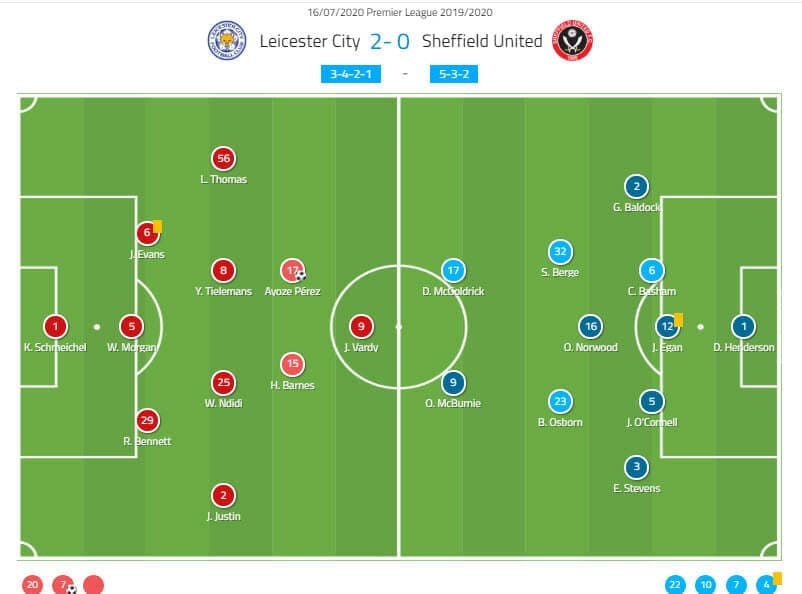
Leicester City: 3-4-2-1
Rogers makes four changes to the side that fell to a 4-1 loss against Bournemouth last week.
Kelechi Iheanacho, Christian Fuchs, Marc Albrighton, are absent through injury while Calgar Söyüncü misses out through suspension. Harvey Barnes accompanies Jamie Vardy and Ayoze Pérez upfront while Wes Morgan and Ryan Bennett complete the back three alongside Johnny Evans.
The fourth and final inclusion to make up the Foxes starting XI, to the surprise of many, was young English prospect Luke Thomas who played 96 minutes as left-wing-back. The 19-year-old stepped up to the plate and impressed on his debut. Winning 60% of his defensive duels against a physical and experienced opposite number, Thomas also had a lot of success going forward. Accomplishing a 50% success rate in both dribbles and crosses, Thomas looks a proficient winger who is capable of creating chances from wide areas, and I fully expect we will see plenty more of the young English man in the future.
Sheffield United: 3-5-2
Chris Wilder stuck with the same starting XI that saw them triumph over Chelsea 3-0 in the previous game week. With almost a complete roster at his disposal Blades boss trusted his experienced side go out and earn another three points on the road to Leicester.
The tried and trusted Dean Henderson is the last line of defence as he starts between the posts. Chris Basham, John Egan and Jack O’Connell make up the backline while wing-backs Enda Stevens and George Baldock command the flanks. The mobile trio of Oliver Norwood, Sander Berge and Ben Osborn operate from the middle just behind the strike partnership of Oliver McBurnie and David McGoldrick.
Foxes uncut by Blades attack
Across the 90 minutes, Sheffield Utd was very dynamic and adaptable in possession; however, as the xG rating of 0.36 would suggest the Blades never seemed to look threatening when entering the final third.
Depending on several factors around Leicester’s defensive organisation Sheffield would either build-up from the back to play through the units or exploit a high defensive line with long-diagonal passes to Leicester’s weak side.
Sheffield struggled to receive and play passes through the middle third successfully; this was due to Leicester’s compact defensive organisation as well as their numerical superiority in midfield. As a result, the Blades opted for long goal kicks and long passes from deep to target the physically proficient McBurnie and McGoldrick for knockdown headers to oncoming midfielders in support.
Although Sheffield’s forwards were often successful in meeting ariel balls in the attack, Leicester’s tactically acute manager and experienced centre-backs were perfectly capable in reading and nullifying this threat from the Blades. With only 45% possession, Sheffield failed to conjure much in attack creating only 3 shots on goal, of which ‘0′ hit the target.
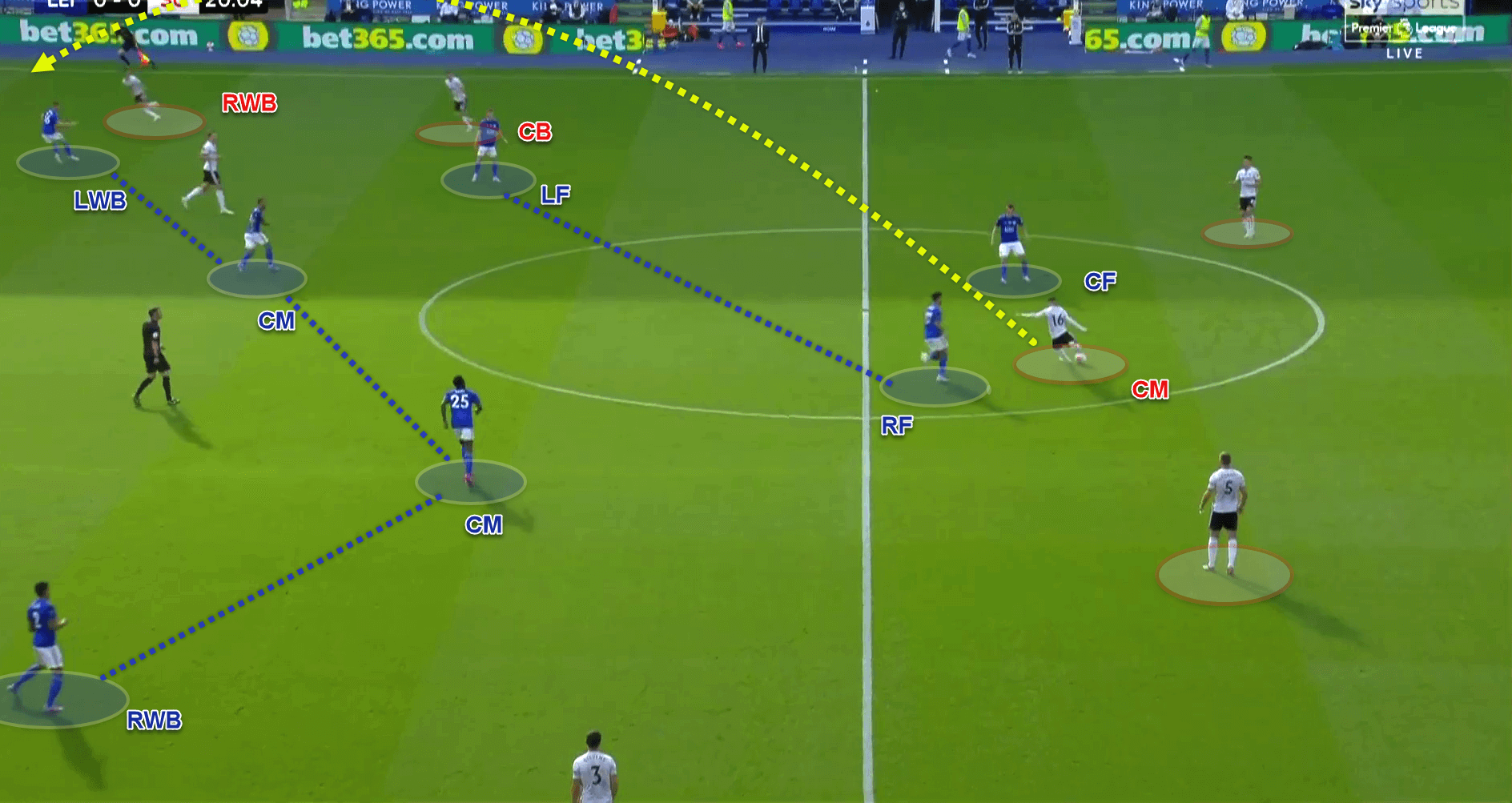
Above we see an example of how Leicester neutralised Sheffield’s build-up, ultimately forcing central-midfielder Norwood to drop deep and play long passes behind the Foxes defensive unit. First Leicester would form a mid-block to receive the build-up play from Sheffield. Vardy’s role is to block horizontal passes at the ideal moment to create traps for the centre-back in possession. Barnes and Pérez who play just behind Vardy would engage any ball carriers driving forward from deep while the four midfielders behind would man-mark and screen forward passing options.
Ultimately this forced Sheffield to play long passes forward, however that was not entirely to the Blades disliking. Wing-backs Stevens and Baldock were high and wide, ready to meet the long passes forward from deep. Although neither wing-back had sufficient time or space to create any fruitful attacks.
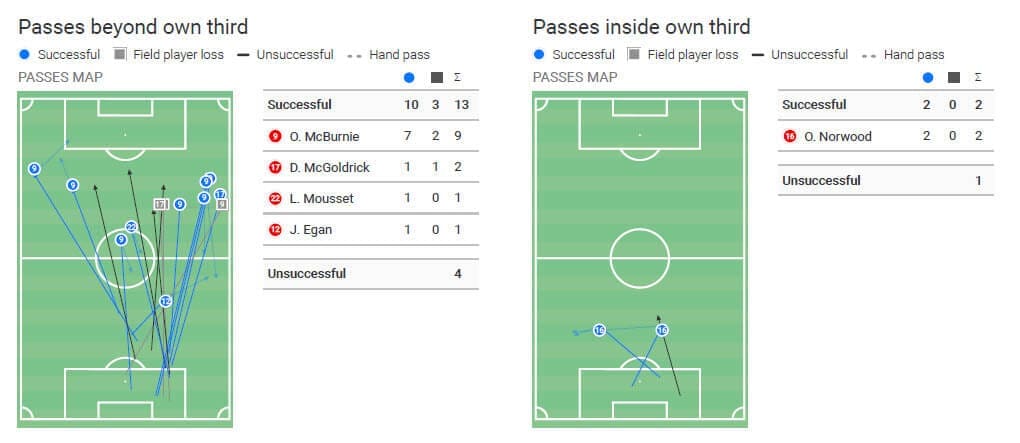
Above we see Dean Henderson’s distribution, both short and Long.
The volume of long passes in contrast to short passes suggest Sheffield Utd aimed to target their physically capable forwards within the channels to progress the attack.
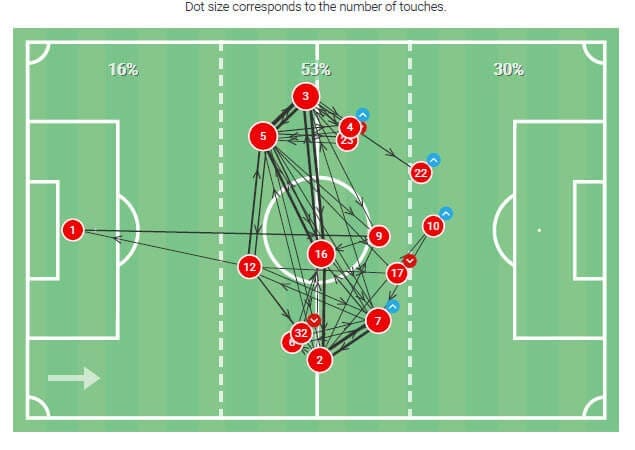
Above, we also see Sheffield Utd’s passing network.
It is evidently clear the Blades struggled to combine well and play forward through the middle third during the build-up phase.
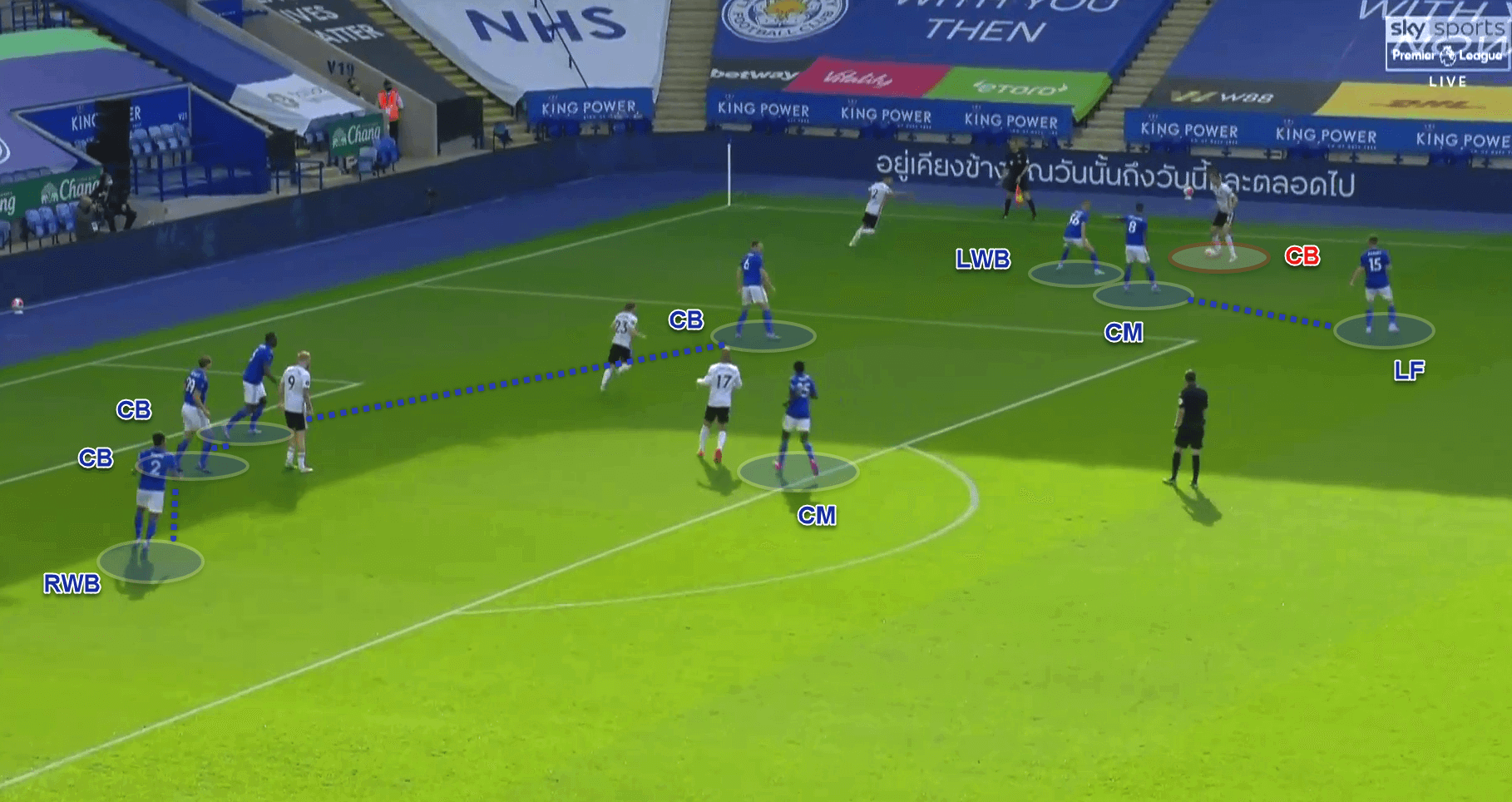
Above we see how Leicester neutralised the Blades in wide areas. Knowing full well Sheffield would look to create their chances from out wide either by well-timed crosses or from combinations running into the box, Leicester were disciplined in meeting and shutting down these attacks.
First, observe the player in possession, Sheffield’s centre-back. Notice how Leicester commit three players into the channel to deny numerical superiority, room to dribble and sufficient space to cross.
From 11 attempted crosses, only 3 successfully met the head of the striker (27% accuracy).
Above, we can also note how Leicester’s defensive unit is well-positioned to defend any potential crosses into the box. First, there are three defenders between the width of the posts while they are also slightly deeper than the forwards such that they execute a defensive header facing up the field.
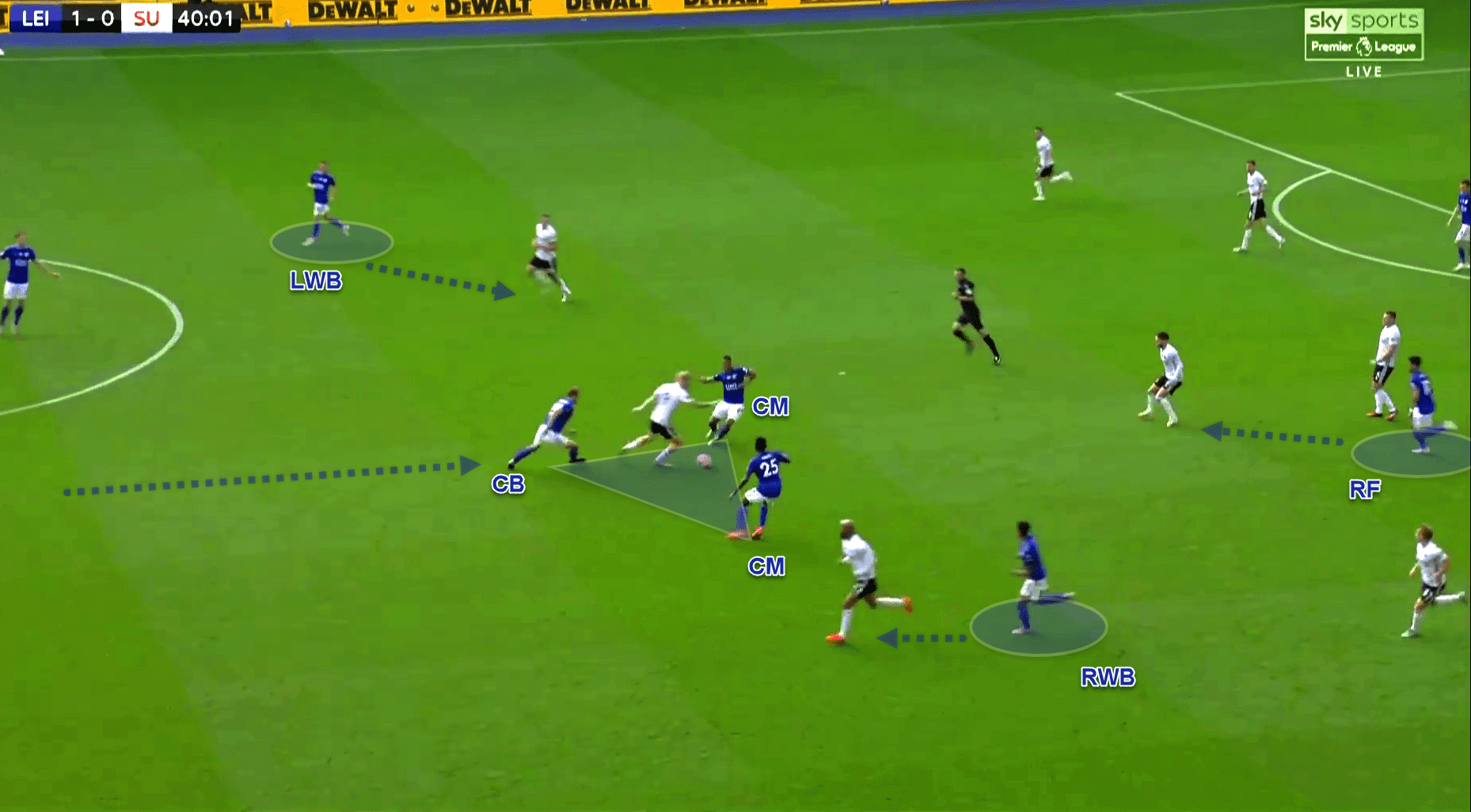
In the image above, we see what illustrates both teams behaviour in transition.
Leicester was very alert to loose balls and the moments when they had just turned over possession.
Above we see a moment when Leicester lose possession from their throw-in, Blades forward McBurnie picks up the loose ball and without a chance to take a second touch three blues shirts close in on him.
Observe also, how the Foxes wing-backs immediately sprint back to deny forward passing options in the channels. Sheffield Utd had ‘0’ counter-attacks in this game, a stat I would out down to two factors; first, Wilder’s side will often try to play back, away from pressure and another build from deep after winning possession. Secondly, the Foxes were, aggressive and disciplined when in the transition to defend, cutting down attacks at their inception.
The ball carriers between the lines find the answer
Both teams were, organised, sharp and disciplined for 90 minutes however in games where defences are tight, and combination passes forward are denied in tight spaces it is the ball carriers with an edge that make the difference. Sheffield United’s defence has rightly earned its compliments from their performances this season, neutralising the big hitters of the Premier League in front of goal.
Roger’s knew he would require players who can change the picture of the attack with individual brilliance along with the ability to finish, and that is exactly what we saw. Vardy, Barnes, Pérez and Gray done superbly well to receive between the lines and advance attacks. As well to make well-timed runs into goal scoring positions and skip challenges in one-versus-ones. This was what made the difference, and because of the horizontal dribbling and uncanny key passes, Sheffield had their work cut out to kill the Foxes in front of goal.
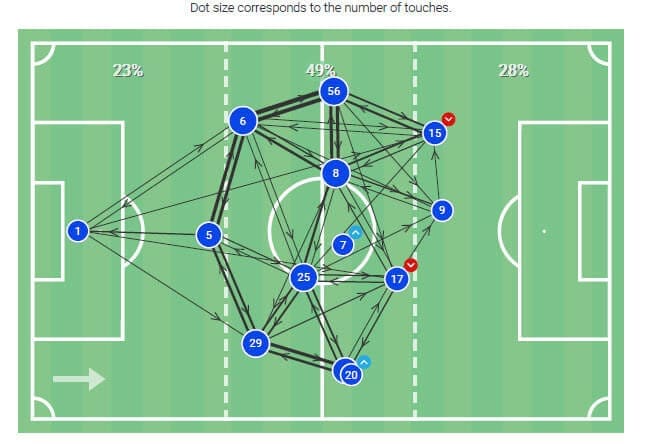
A well-balanced passing network, above, we see Leicester’s passing network.
The density throughout all of the lines both horizontally and vertically shows Leicester were proficient and caple to play through the middle third in the build-up phase. With 55% possession, we see how purposeful Rogers side was in contrast to Sheffield United.
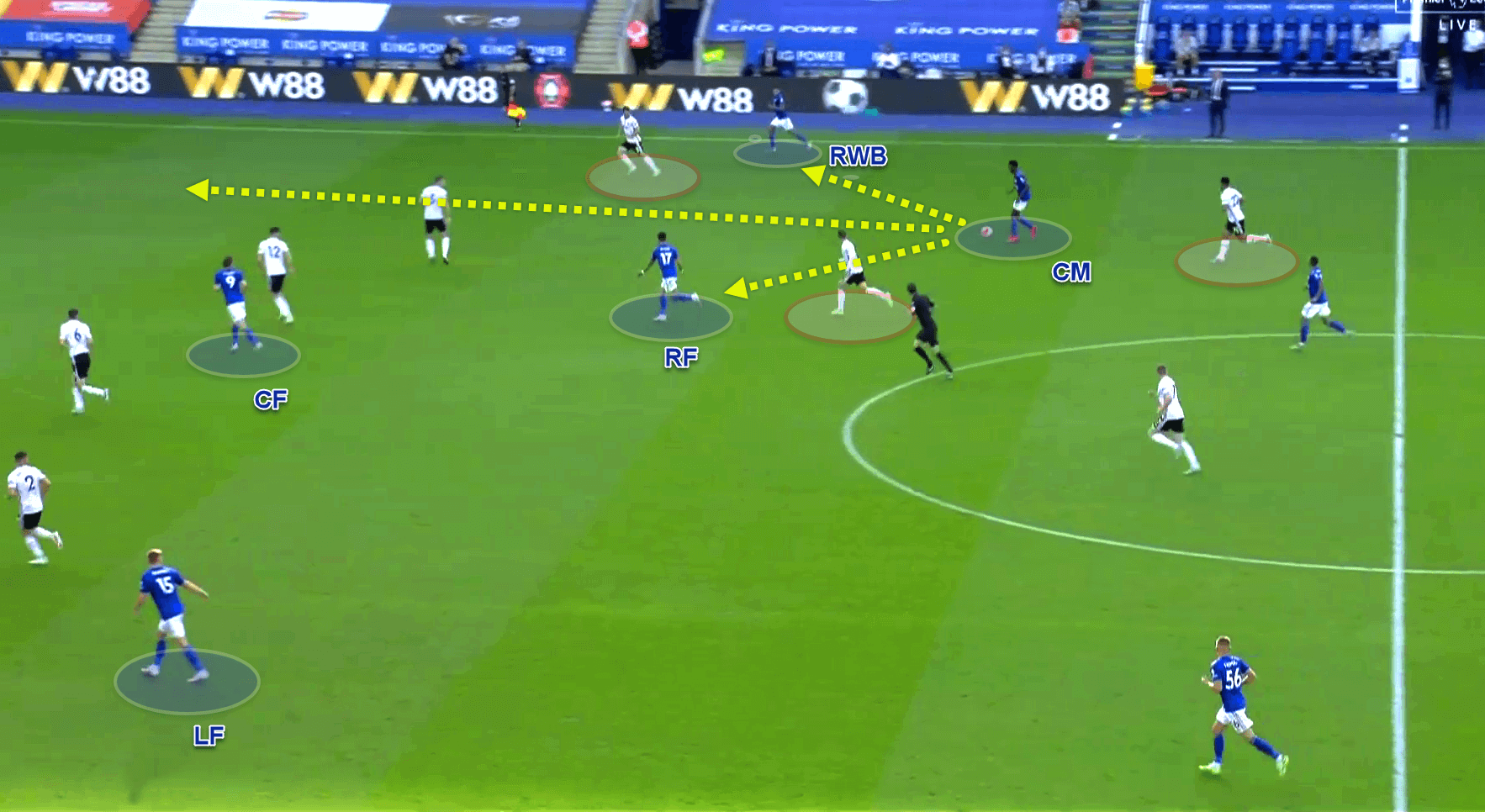
In the image above, Leicester has just won back possession and have immediately moved forward in the transition to attack. Notice the functions that the Leicester players serve as Wilfred Ndidi carries the ball forward. Immediately to the right its wing-back on wing-back holding the width. Just to the ball carriers left, Pérez holds his run to receive a forward pass that is still between the lines.
As a result, notice how none of the highlighted Sheffield United players presses Ndidi, as this would cause Leicester to play a penetrating pass in behind. Finally, Vardy does well to read the opportunities available to him, as if one of the back three were to step out and press the Foxes target man would move into that space and receive a through ball unmarked.
Leicester had 7 counter-attacks in the game, in contrast to ‘0’ from the blades. One of which resulted in their second goal.
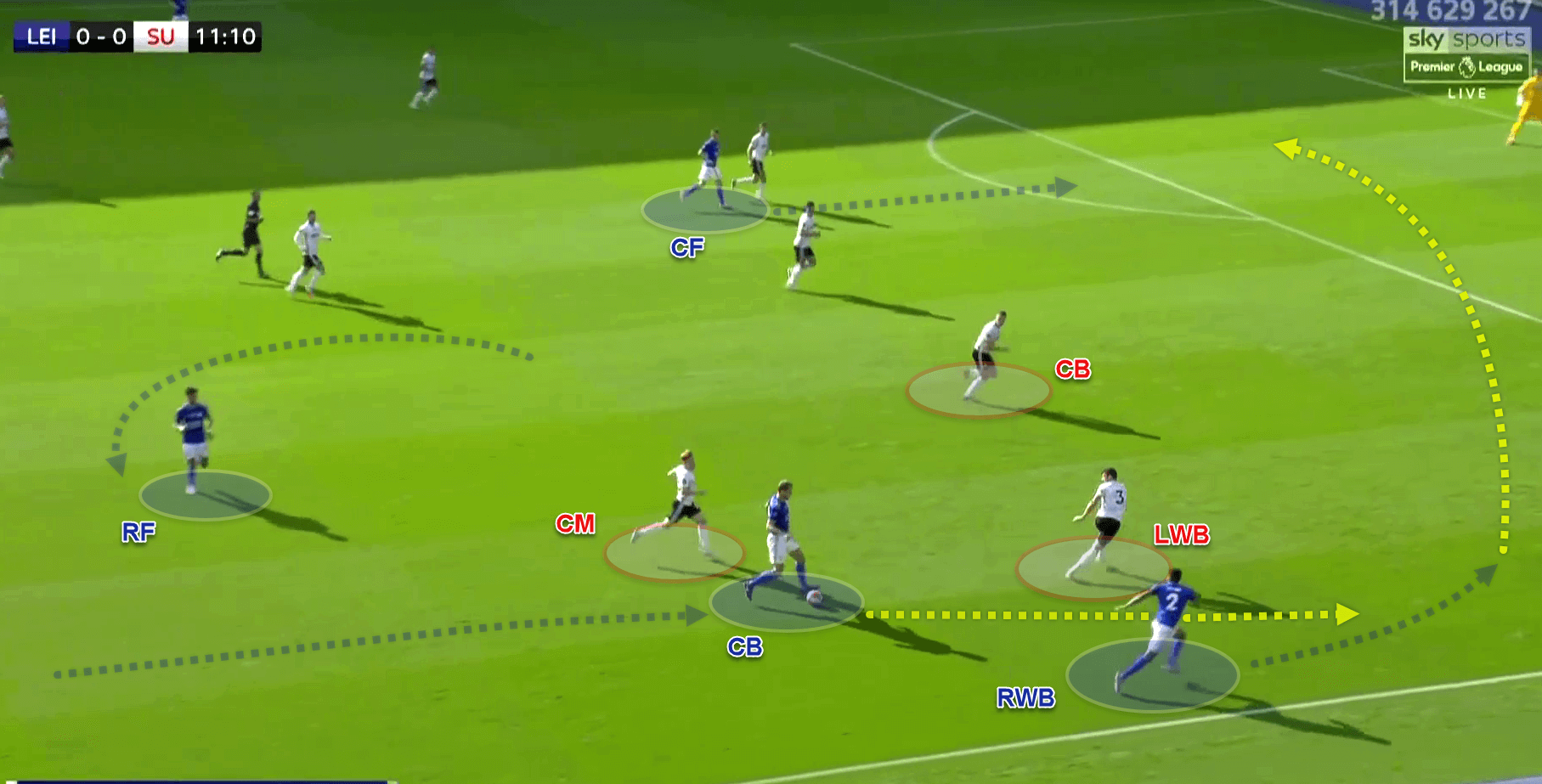
In the build-up, Leicester was able to play around and through the first line of pressure from Sheffield Utd as the back three used their numerical superiority against the two forwards of Sheffield to get by with well times horizontal passes to the weak side. This usually came as Sheffield Utd would also form a mid-block and then engage the press at the most opportune time.
As a reward for their patience, Leicester would execute a switch to the weak side of Sheffield Utd and drive as forward to progress the attack to the final third.
In the image above, we see Bennett, the Foxes centre-back carry the ball as far forward as he can before he is engaged by either a recovering midfielder or a Sheffield defender. Before he has to release the forward pass to the winger notice he has already got to the final third. From this chance, the wing-back can cross into the target man Vardy against an unorganised defence.
Another important point to highlight, as it was key to Leicester getting success, notice the position of the right-forward, Pérez. Pérez loses his marker by dropping deep into the half-space where he is then able to receive passes, dribble forward and across the field and release penetrating passes to Barnes or Vardy in central areas.
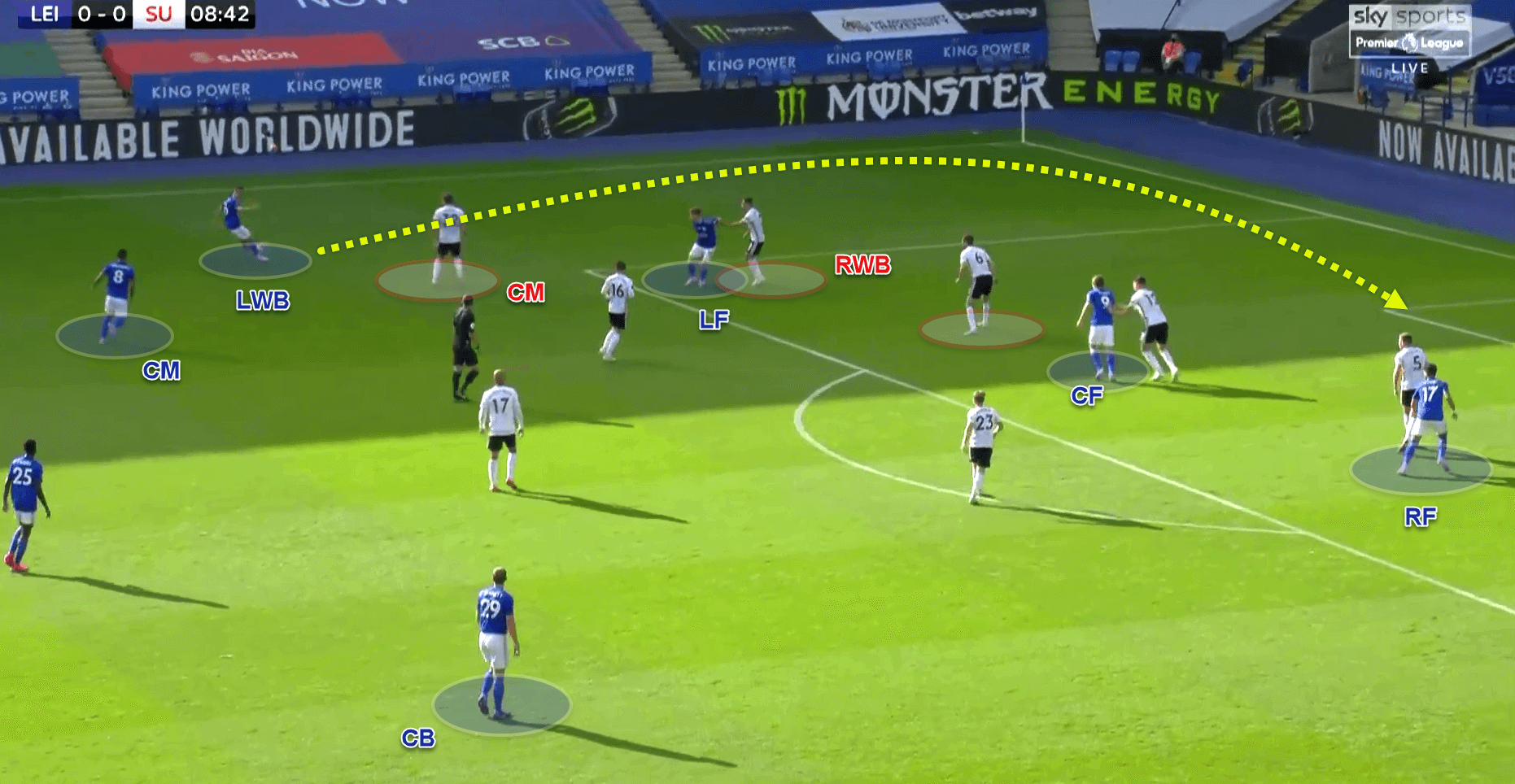
Above we see how Leicester targeted success from wide areas. Debutant Thomas serves a cross from the left, while four Foxes forwards lineup in the box, one of which is out of frame on the wide right, wing-back Justin who is best placed to meet a cross between the posts.
Leicester’s wing-backs are able to create crossing opportunities due to the inventive movement of the front three which serve to engage the Sheffield wing-backs allowing sufficient time and space for wing-backs to provide crosses. Leicester attempted 26 crosses, of which 7 found their target (27% accuracy)
Ultimately it was an unmarked Pérez who hit hard in low late in the first half to give the hosts a lead going into the break, only for substitute Gray to link up well with Vardy through the second half to secure a 2-0 win. Credit to Roger’s and his staff for their tactical masterclass to neutralise the blades and take all three points.
Conclusion
Rogers will be happy his side have made a return to winning ways, in a fashion we have known them for most of the season, with a solid defence. Leicester City travels to Tottenham Hotspurs on Sunday, for a game that will be crucial in deciding their fate as a Champions League team for the forthcoming season.
Similarly, Wilder will need to reinvigorate the Blades attack as he prepares his side for a home tie against Everton next week. Sheffield United still have a chance secure Europa League qualification however it does depend on the results of other sides in the top half of the table.
The Foxes take all three points from this tie, credit to a solid defence and quality strikeforce to guarantee a win and a chance to be called a top-four club in the 2019/20 season.




Comments